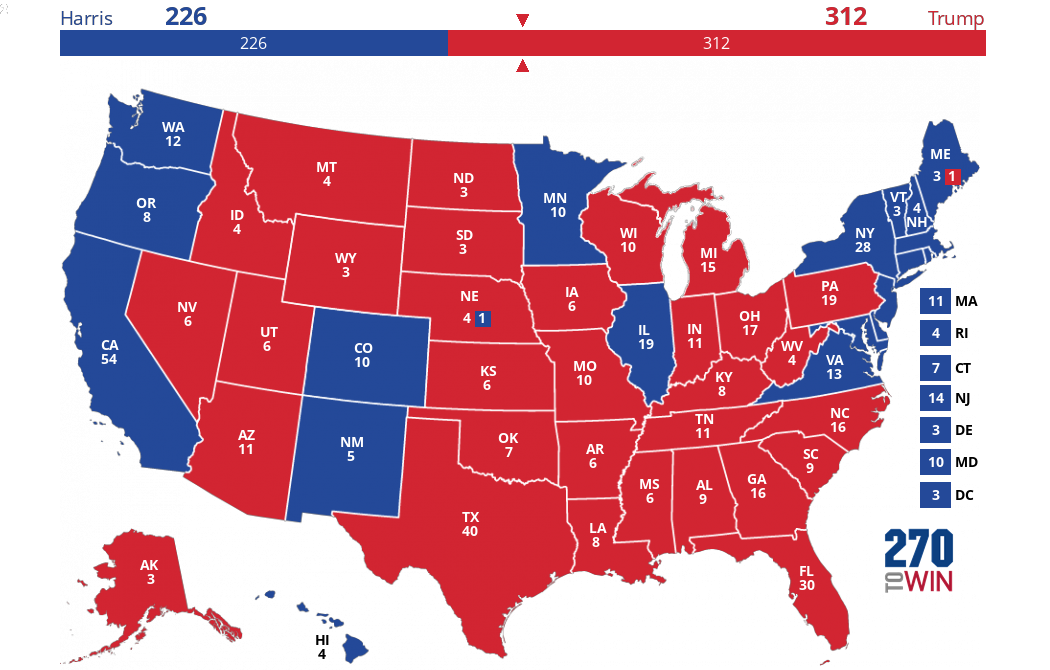Minnesota
Minnesota, cobbled together from land that was part of the original United States, land acquired in the Louisiana Purchase and land acquired from Great Britain in 1818, joined the Union in May, 1858. Minnesota voted exclusively Republican from 1860 through the onset of the Great Depression, except for 1912 when it sided with Progressive candidate (and former Republican) Theodore Roosevelt. From 1932 onward, the state has primarily voted Democratic, last voting Republican during Nixon’s landslide victory in 1972. Outside of Washington, D.C., it is the longest Democratic streak in the country. In 1984, Minnesotans gave homegrown Senator Mondale his only state in the lopsided loss to Ronald Reagan. In 2024, Kamala Harris won by 4% over Donald Trump.
Minnesota has had 10 electoral votes since the 1964 election. It was projected to lose one after the 2020 Census, but edged out New York for the 435th congressional district.
ELECTORAL VOTES
10Recent Presidential Elections
| 2024 |
|
|||
| 2020 |
|
|||
| 2016 |
|
|||
| 2012 |
|
|||
| 2008 |
|
|||
| 2004 |
|
|||
| 2000 |
|
Presidential Voting History
State voted with the overall winning candidate
Electoral College Votes
Colored bars represent electoral votes by party. Tap or hover to see names.
Gray indicates available electoral votes that were either not cast or cast for a candidate not on the ballot.
U.S. Senate Voting History
| Class† | 1988 | 1990 | 1992 | 1994 | 1996 | 1998 | 2000 | 2002 | 2004 | 2006 | 2008 | 2010 | 2012 | 2014 | 2016 | 2018 | 2020 | 2022 | 2024 |
|---|---|---|---|---|---|---|---|---|---|---|---|---|---|---|---|---|---|---|---|
| 1 |
R
|
R
|
D
|
D
|
D
|
D
|
D
|
||||||||||||
| 2 |
D
|
D
|
R
|
D
|
D
|
D
|
|||||||||||||
| 3 |
Data: MIT Election Data and Science Lab / Harvard Dataverse through 2018; 270toWin research. These are general election results for the years listed. Special elections, if any, are excluded.
† There are three classes of Senators; one is up for election every second year. Each state has one Senator in two of the three classes.
U.S. House Voting History
| District | 1988 | 1990 | 1992 | 1994 | 1996 | 1998 | 2000 | 2002 | 2004 | 2006 | 2008 | 2010 | 2012 | 2014 | 2016 | 2018 | 2020 | 2022 | 2024 |
|---|---|---|---|---|---|---|---|---|---|---|---|---|---|---|---|---|---|---|---|
| 1 |
D
|
D
|
D
|
R
|
R
|
R
|
R
|
R
|
R
|
D
|
D
|
D
|
D
|
D
|
D
|
R
|
R
|
R
|
R
|
| 2 |
R
|
R
|
D
|
D
|
D
|
D
|
R
|
R
|
R
|
R
|
R
|
R
|
R
|
R
|
R
|
D
|
D
|
D
|
D
|
| 3 |
R
|
R
|
R
|
R
|
R
|
R
|
R
|
R
|
R
|
R
|
R
|
R
|
R
|
R
|
R
|
D
|
D
|
D
|
D
|
| 4 |
D
|
D
|
D
|
D
|
D
|
D
|
D
|
D
|
D
|
D
|
D
|
D
|
D
|
D
|
D
|
D
|
D
|
D
|
D
|
| 5 |
D
|
D
|
D
|
D
|
D
|
D
|
D
|
D
|
D
|
D
|
D
|
D
|
D
|
D
|
D
|
D
|
D
|
D
|
D
|
| 6 |
D
|
D
|
R
|
D
|
D
|
D
|
D
|
R
|
R
|
R
|
R
|
R
|
R
|
R
|
R
|
R
|
R
|
R
|
R
|
| 7 |
R
|
D
|
D
|
D
|
D
|
D
|
D
|
D
|
D
|
D
|
D
|
D
|
D
|
D
|
D
|
D
|
R
|
R
|
R
|
| 8 |
D
|
D
|
D
|
D
|
D
|
D
|
D
|
D
|
D
|
D
|
D
|
R
|
D
|
D
|
D
|
R
|
R
|
R
|
R
|
Data: The Princeton Gerrymandering Project through 2018; 270toWin research. These are general election results for the years listed. Special elections, if any, are excluded.
Vertical lines before 1992, 2002, 2012, and 2022 show Census-related redistricting breakpoints. Geographic borders associated with each district number are likely to have changed.
The state had an additional redistricting before 1994.
Governor Voting History
Data: Wikipedia through 2018; 270toWin research. These are general election results for the years listed. Special elections, if any, are excluded.

